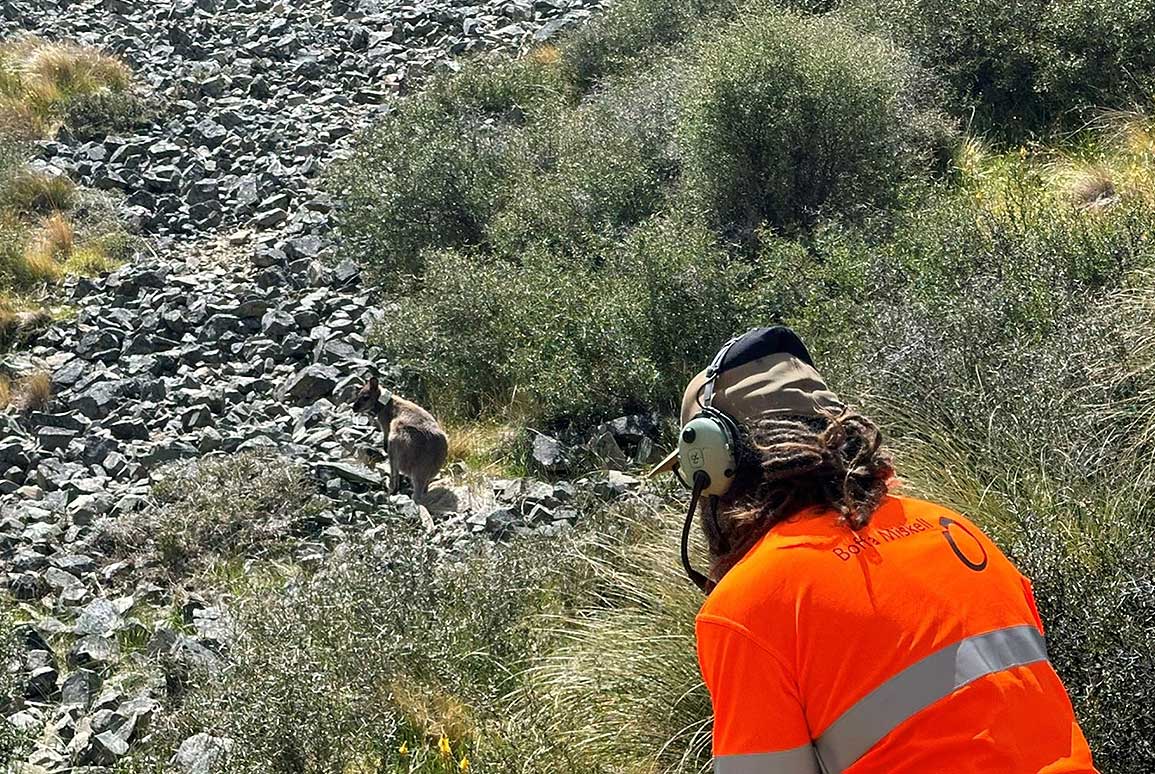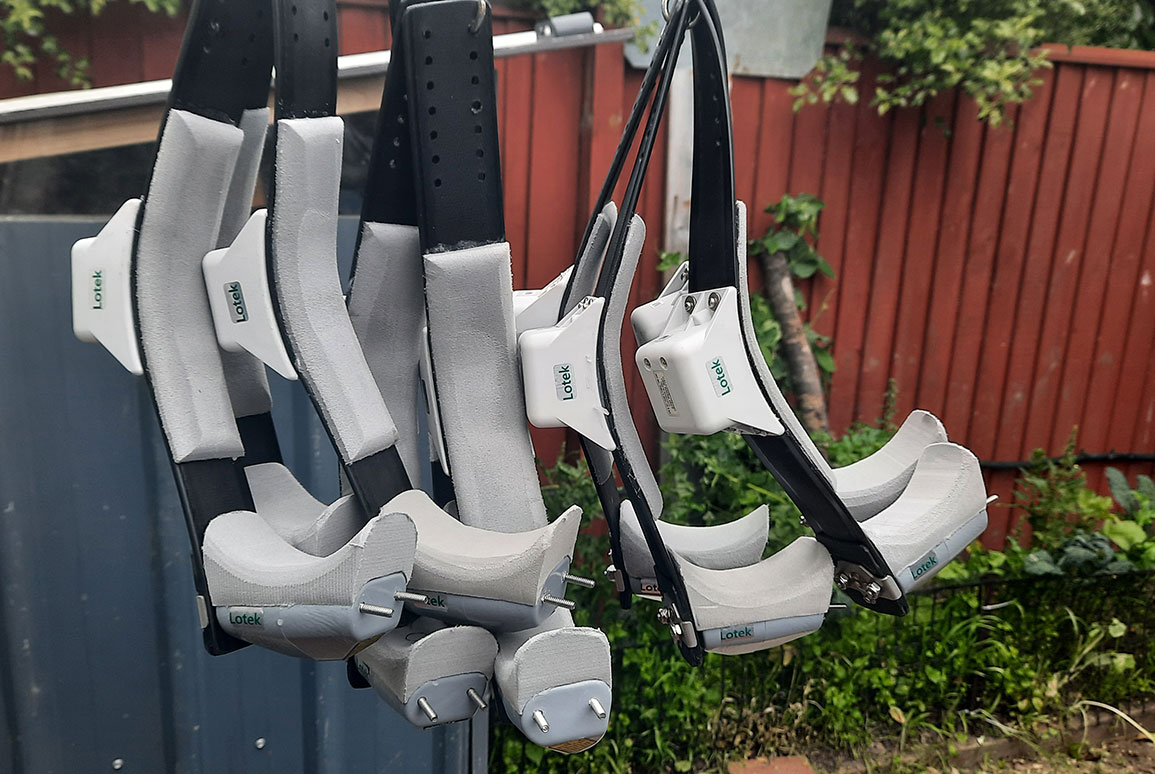‘Undercover agent’ wallabies are released in South Canterbury
21 December 2023
A new strategy for controlling Bennett’s wallabies in South Canterbury is underway, with Boffa Miskell biosecurity consultants playing a lead role.

Ten wallabies wearing GPS collars were released into remote terrain, where they will act as ‘undercover agents’ to lead pest control contractors to other individuals of this invasive species.
Using collared animals to find other members of the same species is a common strategy in feral goat, pig and tahr control, but this is the first time the technique has been trialled with wallabies. The two-year operation is as much about gathering data to inform strategic decision-making as it is about immediate pest control.
Boffa Miskell biosecurity consultant Pete Caldwell has a long-standing interest in wallaby management. In 2018, his research proposal “Determining the Invasion Front of Wallabies” received funding under the Boffa Miskell Research Programme. He says learning more about wallaby behaviour, detection and distribution is an essential part of formulating an effective control strategy.
“Releasing and tracking wallabies is something that we’ve been talking about for a long time,” he says. “Although not a new idea, it’s a strategy that has been proven to work well with other species. This operation will determine whether it’s feasible for wallaby control in the long-term.”
Five species of wallabies were introduced to both the North and South Island of New Zealand from Australia in the late 1800s. They were brought here for their pelts and recreational hunting and, without natural predators, adapted well.
Three of those species have become significant pests. The dama wallaby and parma wallaby are found in the North Island, largely around the Rotorua Lakes area. In the South Island, it is estimated that Bennett's wallabies occupy around 1,000,000 hectares of remote land in South Canterbury and Otago, including some areas where wallabies are at very low density. Traditional methods of control – essentially hunting wallabies across the wide landscapes and challenging terrain they typically inhabit -- is a labour-intensive task and has been unsuccessful at fully eliminating the population.
This new initiative is being undertaken by Otago Regional Council in collaboration with Environment Canterbury and the Tipu Mātoro National Wallaby Eradication Programme.
“Ten wallabies – both male and female – were captured with ground nets, and then de-sexed and evaluated to ensure they were in good health before being released,” Pete explains. “We used helicopters to access remote terrain and released them in a number of locations where there are low densities of wallabies.
“It’s possible that because wallabies tend to be found in small clusters, these individuals will seek out others. We will track them daily through satellite and every month we’ll send an aerial hunting unit with thermal cameras to target any non-collared wallabies within 1km of the collared individuals.”

The tracking data from the GPS collars will be analysed and will provide much-needed insight into wallaby behaviour in the wild.
“What we learn from these collared wallabies will help determine whether this is a useful technique in the long-term,” says Pete. “There’s a lot we don’t know about wallaby behaviour. What we do know is that even the most experienced pest control contractors will still miss some wallabies in these vast landscapes. GPS tracking will fill in some knowledge gaps and bring greater efficiency to whatever control operation we undertake.”
Wallabies are a cryptic species, being largely nocturnal, often sleeping in thick vegetation and having a pelage that blends well with their surroundings. They are reasonably social, when one is found, there tends to be a few individuals found in that area. It’s uncertain whether individuals frequently move between groups; and, if they do, whether that movement is for social or feeding reasons.
Greater understanding about site fidelity and population dispersal (how far an individual will travel) is also expected to come from the tracking data, and it’s anticipated that increased knowledge will result in a more cost-effective and efficient control strategy in the long-term.
The annual cost in lost agriculture revenue associated with wallabies in the South Island is in the tens of millions, and that cost will increase exponentially if wallabies continue to spread without active management. Pete Caldwell says the up-front cost of this research is money well-spent.
“Helicopters, GPS collars, the cost of on-going tracking and data analysis… admittedly, all of that is more expensive than what we’re currently doing – which is predominantly going out in the field and hunting with ground-based teams and some aerial control,” Pete continues.
“But hunting alone hasn’t been getting the job done, so we need to learn more and we need to explore other options.”
In 2022 there were 327 reported sightings of wallabies, compared with 550 this year. Testing the usefulness of ‘spy’ wallabies would provide a new tool in the battle to control this cryptic pest.
“Developing methods to prevent wallaby dispersal beyond current boundaries is needed, and a focus on research, proactive surveillance and control, and early detection -- particularly in areas where we have low wallaby numbers -- is a key part of that process,” says Pete.
“What we’re doing could make a significant difference in our efforts to eradicate Bennett’s wallaby from Otago and South Canterbury, and protect the remaining regions from having to deal with this pest.”

